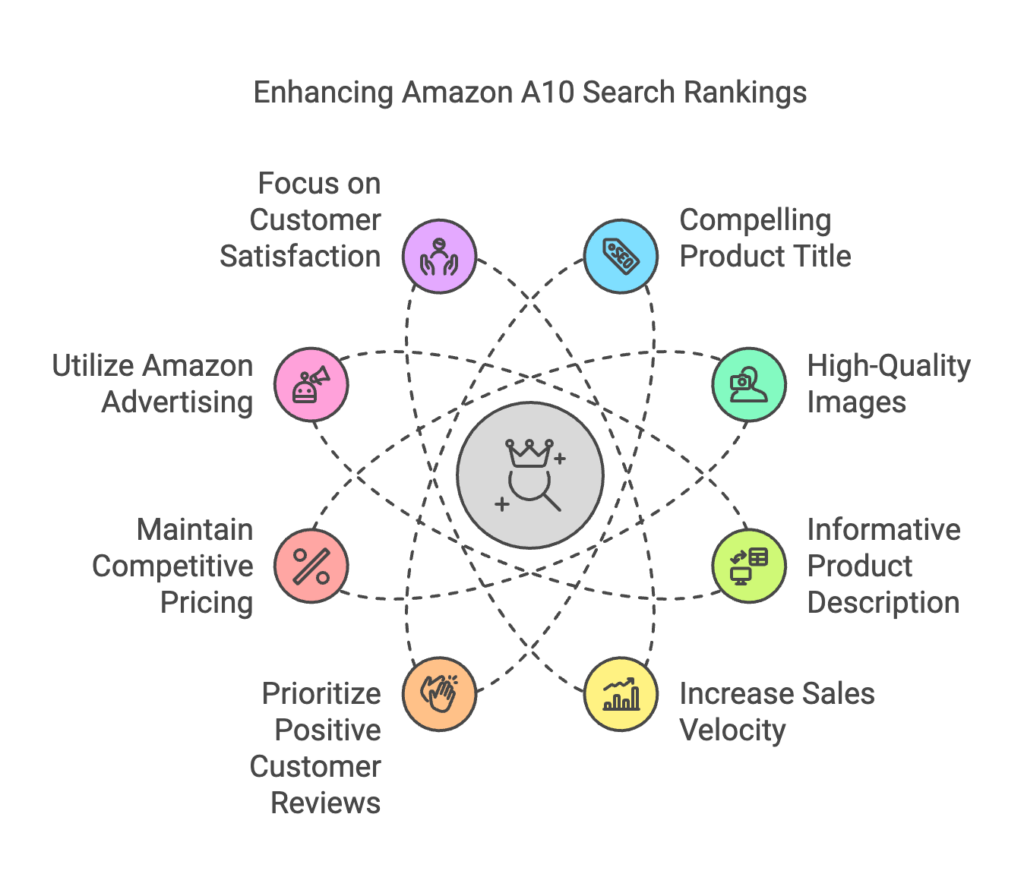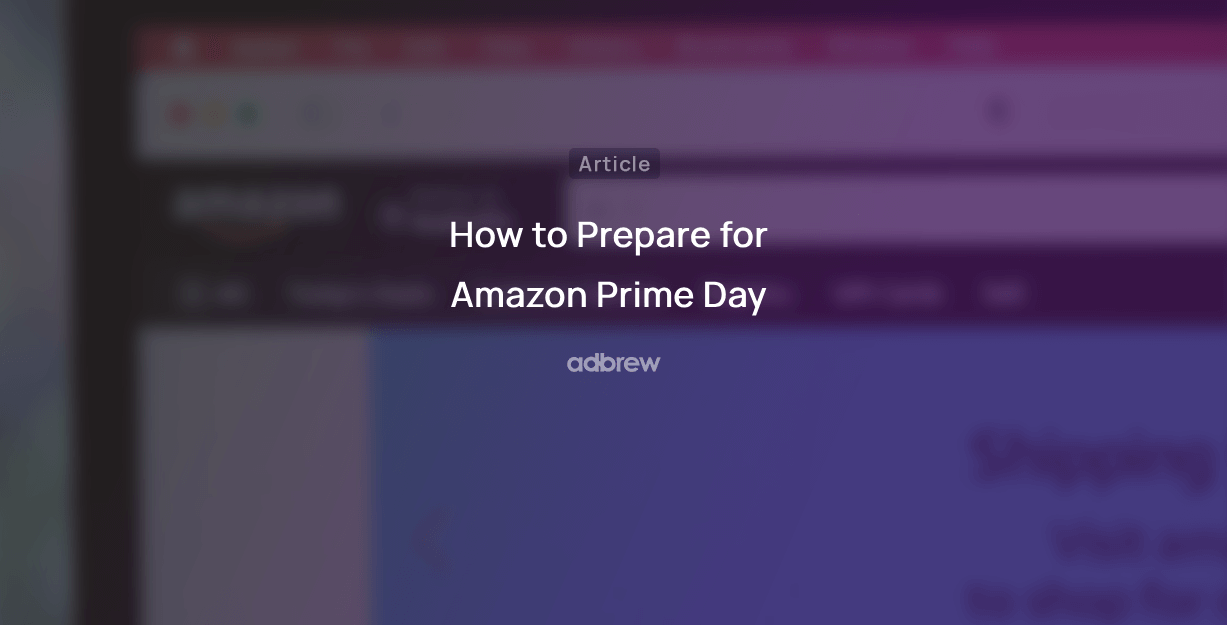
Introduction
Tired of your product getting buried in Amazon search results? Ever wonder what makes certain products consistently climb to the top?
The secret lies within the powerful Amazon A10 algorithm, the gatekeeper to Amazon’s search paradise.
In this blog post, we’ll break down the A10 algorithm for you. We’ll uncover its secrets, show you how to leverage it for success, and equip you with the knowledge to dominate the Amazon marketplace. No matter if you’re a seasoned seller or a complete newbie, this guide will give you the edge you need to thrive.
Let’s begin!
What is Amazon A9 Algorithm?
Before dissecting the A10 algorithm, it’s helpful to understand its predecessor, A9. Launched in 2004, A9 was the original search engine algorithm powering product ranking on Amazon. Its primary focus was on keyword matching – products with titles and descriptions packed with relevant keywords enjoyed higher visibility. While keyword optimization remain important, the A10 algorithm takes a more holistic approach, prioritizing factors that enhance the overall customer experience.
What is Amazon A10 Algorithm?
The A10 algorithm represents a significant shift in Amazon’s ranking philosophy. It prioritizes relevance, going beyond simple keyword matching to truly understand customer intent. A10 analyzes a broader spectrum of factors to determine which products deserve a desired spot on the first page. This refined approach ensures a more positive shopping experience for users, ultimately translating into higher customer satisfaction and sales for sellers who optimize their listings accordingly.
Factors Affecting Amazon A10 Algorithm
Relevance: Relevance refers to how closely a product matches the search query or aligns with a customer’s interests. Amazon’s A10 algorithm prioritizes products that are highly relevant to the search terms used by customers. Optimizing product titles, descriptions, and backend keywords to include relevant keywords can improve a product’s relevance and visibility in search results.
Sales History & Velocity: Consistent sales history and a healthy sales volume (rate at which your products are selling) are strong indicators of a successful product. A10 rewards products with consistent demand by placing them higher in search results.
Customer Engagement: Customer engagement metrics, such as click-through rate, conversion rate, and customer reviews, provide insights into how customers interact with a product. Products with high engagement rates are more likely to be favored by the A10 algorithm as they indicate positive customer behavior and satisfaction.
Pricing: Competitive pricing relative to similar products is a crucial factor in influencing a product’s ranking and sales performance on Amazon. Products priced competitively are more likely to attract customers and achieve higher sales volumes, positively impacting their visibility in search results.
Inventory Levels: The availability of stock directly impacts a product’s likelihood of being displayed in search results. Products with sufficient inventory are more likely to be featured prominently, while products with limited stock may experience fluctuations in visibility based on their availability.
External Signals: Positive mentions, reviews on social media,external traffic, and off-site sales can influence A10’s perception of your brand and product. If your product is generating positive buzz online, it can signal to A10 that it’s a trending or well-regarded option, potentially boosting its ranking.
Fulfillment Method: Products fulfilled by Amazon FBA may receive preferential treatment from the A10 algorithm due to Prime eligibility and reliable shipping. FBA products typically offer faster delivery and better customer service, leading to higher customer satisfaction and improved visibility in search results.
Mobile Optimization: With a growing number of mobile shoppers, A10 prioritizes listings that provide a smooth user experience on smartphones. This includes ensuring your product information is clear and concise on smaller screens, your images are high quality and load quickly, and your call to action is easy to find and tap.
Seller Authority: A10 places a strong emphasis on your reputation as a seller. Factors like positive seller feedback rating, order fulfillment speed, and a track record of excellent customer service all contribute to your seller authority.
Advertising: While not a direct ranking factor, Amazon PPC ads can indirectly improve your organic ranking. PPC campaigns can increase product visibility, drive traffic to your listing, and potentially lead to higher sales velocity and conversion rates, all of which are positive signals for A10.

Difference between Amazon A9 and A10 Algorithms
Amazon’s search engine relies on algorithms to determine which products show up first in search results. There isn’t a clear distinction between a definitive A9 and A10 algorithm. Instead, it’s more accurate to say that A10 represents an evolution of the original A9. Both use many of the same principles, but A10 adds some new wrinkles.
At its core, both A9 and A10 consider factors like product listing details, customer reviews, and sales history to determine a product’s ranking. They also factor in how relevant a product’s keywords are to a customer’s search query. This ensures that shoppers are likely to find what they’re looking for.
One key difference between A9 and A10 lies in how they handle external data. A9 primarily focused on information within the Amazon ecosystem. A10, however, incorporates external signals as well. This might include things like social media mentions of a product or how much traffic a product page receives from outside sources. By considering these external factors, A10 aims to provide a more holistic view of a product’s popularity and relevance.
Another potential difference is the weight given to seller authority. While A9 likely considered factors like seller feedback and tenure, A10 might place a greater emphasis on this concept. This could benefit established sellers with a strong track record on Amazon.
Improving Search Rankings on Amazon’s A10 Algorithm
Improving search rankings on Amazon’s A10 algorithm involves several key strategies:

Compelling Product Title: Craft a clear, concise title that showcases the product’s essence and incorporates relevant keywords. Think of it as a captivating headline that grabs attention in search results.
High-Quality Images: A picture is worth a thousand clicks. Invest in professional photos that showcase your product from multiple angles, highlight its features in use, and entice potential buyers.
Informative Product Description: Don’t underestimate the power of words. Provide comprehensive details about features, benefits, and specifications. Use clear and concise language, avoiding jargon.
Increase Sales Velocity: Encourage sales through promotions, discounts, and advertising campaigns to boost organic sales velocity and build a robust sales history, which can positively impact search rankings and seller authority.
Prioritize Positive Customer Reviews: Getting positive reviews from satisfied customers must be prioritised as higher ratings and review counts can improve product credibility and visibility.
Maintain Competitive Pricing: Regularly monitor and adjust product pricing to remain competitive within the marketplace, as pricing can influence purchase decisions and search rankings.
Utilize Amazon Advertising: Leverage Sponsored Products and other PPC campaigns strategically. PPC can increase product visibility, drive traffic to your product listings, and potentially lead to higher sales velocity and conversion rates. Remember, PPC is not a direct ranking factor, but can indirectly influence organic ranking through increased customer searches.
Focus on Customer Satisfaction: Provide excellent customer experience, fulfill orders promptly, and address customer inquiries and concerns promptly to maintain high seller performance metrics, which can positively influence search rankings.
Conclusion
The A10 algorithm may seem complex, but with dedication and these actionable steps, you can unlock its power to propel your products to the top of Amazon’s relevant search results. Remember, the journey to Amazon success is ongoing. Stay informed about Amazon search algorithm updates, experiment with new strategies, and prioritize customer satisfaction.
By continuously optimizing your listings and remaining adaptable, you’ll be well-positioned to conquer the Amazon marketplace and achieve your full sales potential.
Frequently Asked Questions

Does the A10 algorithm apply to all Amazon marketplaces?
Yes, the A10 algorithm is used globally across all Amazon marketplaces to determine product rankings.
How does external traffic impact the A10 algorithm?
External traffic, such as clicks from social media or other websites, can positively influence your product ranking by signaling broader relevance and popularity.
How important is mobile optimization for A10?
Mobile optimization is critical since a growing number of customers shop via mobile, and A10 values listings that provide a seamless mobile experience.
Can I still rank well without using Amazon FBA?
Yes, but FBA products often have an advantage due to Prime eligibility and faster shipping, which are favored by the algorithm.
Recent Posts
Take your Amazon PPC advertising to the next level

Related Blogs
Introduction Walmart is one of the largest online marketplaces globally, with a broad customer base and a diverse range of […]
For sellers on Walmart Marketplace, getting reviews is crucial. Positive reviews enhance your brand’s reputation and increase sales, while negative […]
Introduction Tired of your product getting buried in Amazon search results? Ever wonder what makes certain products consistently climb to […]
The Amazon Cyber Monday and Black Friday sales week is just around the corner. It’s no secret that this marks […]
Amazon Prime Day is one of the largest global e-commerce sales events, attracting millions of customers worldwide. But how do […]







